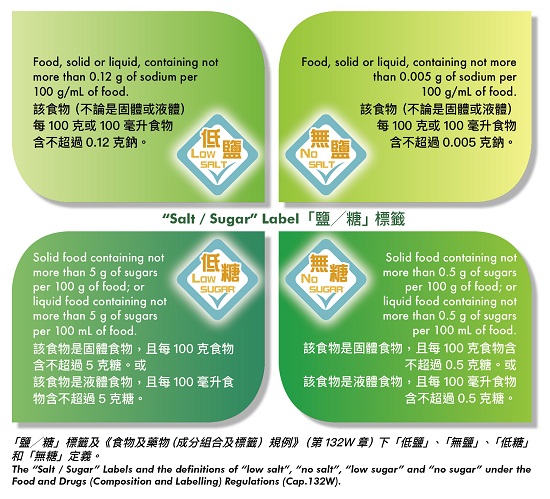
Food Safety Focus (137th Issue, December 2017) – Food Safety Platform
Understanding the “Salt/Sugar” Label Scheme for Prepackaged Food Products
Reported by Mr. Nicky HO, Scientific Officer,
Risk Assessment Section,
Centre for Food Safety
The Committee on Reduction of Salt and Sugar in Food (CRSS) , the Food and Health Bureau and the Centre for Food Safety (CFS) jointly introduced a voluntary “Salt / Sugar” Label Scheme for Prepackaged Food Products (the Scheme) with the support of food trade in October 2017. The Scheme is one of the CRSS’ initiatives to promote low-salt-and-sugar diets in the community.
Reduction of Dietary Sodium and Sugar
Dietary sodium and sugar intakes are closely related to health. Excessive sodium intake will increase the risk of developing hypertension, fatal stroke and coronary heart disease while excessive dietary sugar intake may cause overweight and dental caries.
To echo with the World Health Organization initiatives, promotion of reducing salt and sugar intake for the general population in Hong Kong had been put on the Government Policy Agenda. The CRSS had been subsequently established to advise the Government on the formulation of policy directions and work plans to reduce the intake of salt and sugar by the public, as well as to reduce salt and sugar contents in food.
“Salt / Sugar” Label Scheme for Prepackaged Food Products
The Government and the CRSS jointly introduced the Scheme to assist consumers to easily identify low-salt-and-sugar products and facilitate the public to select food with less salt and sugar by making reference to the“Salt / Sugar” Labels (the Labels). It is also wished that the Scheme will serve as a catalyst for the trade to provide more varieties of low-salt-low-sugar products for consumers. It is expected that prepackaged food products with the Labels would be available in the market soon.
The Labels are available in Chinese, English and bilingual versions, as well as colour and black and white.
The Labels can be displayed on all prepackaged food products that are in compliance with the definitions of “low salt”, “no salt”, “low sugar” and “no sugar” under the Food and Drugs (Composition and Labelling) Regulations (Cap.132W) (see illustration).
How to Participate in the Scheme
The Scheme is voluntary in nature. No prior approval from the CFS is required. Trade members are only requested to notify the CFS by completing the Notification Form of Implementation of “Salt / Sugar” Label Scheme for Prepackaged Food Products. Information of the products under the Scheme will be uploaded to the CFS website.
The Labels should be printed or stuck prominently on the food packaging. The trade may decide the size of the Labels on their own but the Labels should be clear and legible.
The Labels designs and details of the Scheme have been uploaded to the dedicated webpage of the CFS.
Less-salt-and-sugar diet
A less-salt-and-sugar diet is a preferred dietary culture. To avoid adverse health effects caused by excessive intake of salt and sugar, the public is encouraged to develop a healthy eating habit with less salt and sugar. Next time when you purchase prepackaged food products, make smart and healthy choices by reading nutrition labels and choosing food with lower sodium and sugar contents. This can allow the taste buds to become accustomed to food with less salt and sugar.
In addition, trade members should actively participate in reducing salt and sugar contents in foods and make greater efforts to reformulate food recipes to provide more quality foods with less salt and sugar to the public with reference to the Trade Guidelines for Reducing Sodium in Foods and the Trade Guidelines for Reducing Sugars and Fats in Foods developed by the CFS. They can display the Labels on their prepackaged food products which meet the claim conditions of “low salt”, “no salt”, “low sugar” and “no sugar” under the Food and Drugs (Composition and Labelling) Regulations (Cap.132W).



